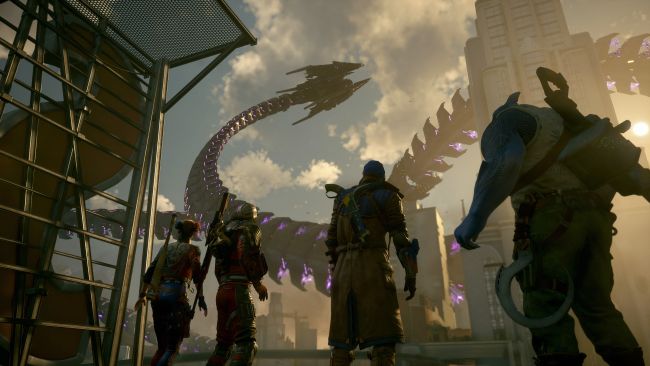As we hope is pretty clear from the text here, this is based on just over seven hours of play time with the final version of Suicide Squad: Kill the Justice League in its current live form. We beat half of the game’s central bosses and did a lot of open-world activities, but of course we didn’t experience the game’s endgame. What follows are some first impressions, which we will eventually pour into a final review that also comments on the game’s long-term potential. Therefore, there is no score.
A while back I published an article in which I rather dramatically proclaimed that Suicide Squad: Kill the Justice League makes me sad. There were many reasons why I used that particular word, because I felt that developer Rocksteady not only followed Arkane, Crystal Dynamics, BioWare and Platinum off the live-service shelf, even though it arguably failed miserably for all of the above studios, it was because by positioning Kill the Justice League as some sort of pseudo sequel to Batman: Arkham Knight, Rocksteady not only robbed us of the fantastic ending to an excellent trilogy of games, they also completely botched the introduction of characters that were only subtly hinted at in Arkham. They have, in retrospect, frayed the edges of their own Batman universe, and they didn’t have to.
Anyway, the point of that paragraph was to illustrate that I’ve already taken the time to complain about the more philosophical aspects of the major design decision Rocksteady (and possibly Warner Bros.) made that brought us to the launch of Suicide Squad: Kill the Justice League, so these first impressions will focus more on more pragmatic things, In other words, more traditional. Because at the end of the day, Rocksteady has to be given a chance.
And there are wins here, make no mistake about that. First and foremost, Rocksteady continues to show us that they are extremely adept at capturing the soul of a specific location and presenting a coherent vision for it. No, Metropolis is no Gotham, nor does this more frenetic gameplay model provide the more introspective, detail-oriented exploration that made the Arkham series so memorable. But that doesn’t mean there isn’t an artistic connection between neighborhoods, lots of narrative detail and the feeling that this… Well, Metropolis, just a few weeks ago, was alive and well as a bustling metropolis. Moreover, Rocksteady is also adept at both creating a solid visual framework for their game universes and nailing the technical achievements behind the curtain. All characters are accurately brought to life, they are all detailed and beautifully realized, and the voice acting across the board is downright excellent.
There are even positive aspects of the game’s core looter shooter gameplay loop to point out. Moving around in Suicide Squad: Kill the Justice League is basically pretty fun. It’s the only way the four heroes are mechanically distinct from one another, but they also feel different, and it remains the main reason you switch between them during a playthrough, because it’s fun to see how fluidly you can sustain your journey across the rooftops of Metropolis.
But there are problems here, so many problems, and even though I haven’t finished the game yet, it’s hard to imagine these not sticking in your mind or even growing and becoming more noticeable as the hours pass. In fact, there are so many that it’s hard to know where to start, so to maintain that these are preliminary first impressions, here they are in a relatively disorganized stream.
While moving is entertaining, a large part of the overall combat loop consists of moving to where the enemies are, and because Metropolis is designed so vertically and enemies almost always teleport to an elevated position, you spend a lot of time doing things that have nothing to do with your weapons, which doesn’t seem particularly intuitive when the desire to constantly get better loot is a pretty crucial part of… Yes, a looter-shooter with a tiered loot system (by which we mean the classic color-coded qualities of all the game’s equipment). Moreover, these enemies are endlessly anonymous and boring to shoot, and have yet to produce any exciting variety. There are regular purple monster aliens, sniper purple monster aliens, heavy purple monster aliens, and let’s not forget tanks and helicopters possessed by purple monster aliens. They are never scary or exciting, and are just as fun to fight against as the countless A.I.M. robots you smashed to pieces in Marvel’s Avengers.
The interface is busy to say the least, and by busy I mean cluttered, and by cluttered I mean the exact opposite of streamlined and precisely designed to give you the information you absolutely need while keeping an overview of what’s happening on the battlefield. There is a communication interface on the right, a Gears of War -like active reload system in the middle, state modifiers on the left, cooldowns on the bottom, an active combo in the upper left corner and I could go on and on. Of course you learn to focus your attention where it’s needed, but it’s disjointed to say the least as it stands.
Most of the activities, aside from the core missions which, according to journalists and content creators who have already completed the campaign, take about 10 hours if you hurry, consist of fairly generic setups where you defend a particular point, save Rick Flagg’s soldiers in some sort of time trial or crush enemy strongholds. As far as I can tell, aside from Riddler challenges (which are still pretty fun, I’ll admit), there are no special sets of side missions that introduce meaningful characters or ask you to take on a specific villain, like in Arkham City and Arkham Knight.
Like Anthem, the loot in this looter-shooter is stunningly boring. During the first hour I was presented with two legendary weapons, and these offered little more than large stat boosts and status effects, such as setting enemies on fire or even turning them to ice. While this may indeed change in the game’s endgame, it is not promising for a game designed in part to hold your attention much longer than just until the campaign’s credits roll.
I could go on, I really could, because while the entertainment factor may be relatively high, there are fundamental problems that Rocksteady just doesn’t manage to address in a satisfactory way. We’re talking about basic things like encounter design, combat loops, topography that allows for varied combat, missions that are diverse and offer versatile narrative approaches and…. Well, loot that you really look at and work hard to get your hands on.
Make no mistake, right now I’m enjoying Suicide Squad: Kill the Justice League because Rocksteady basically has a fun idea for another DC story, and they tell it with enough flair and with great visuals and solid voice acting. But it may take another 10 hours, if not less, and then it’s all about mechanics, encounter design and the way the open world is structurally built to hold my attention. I just don’t think Suicide Squad: Kill the Justice League can sustain that, but I’ll keep giving it GAAS (get it?), and will come back in a week or so with a fuller verdict.





 2024 BAFTA Games Awards: all categories and nominees -.
2024 BAFTA Games Awards: all categories and nominees -. Everything you need to know about Amazon’s Fallout ahead of release: we talked to the creators – Fallout (Amazon)
Everything you need to know about Amazon’s Fallout ahead of release: we talked to the creators – Fallout (Amazon) 10 hidden gems on Apple Arcade –
10 hidden gems on Apple Arcade – Oscars 2024: all categories and winners –
Oscars 2024: all categories and winners – Netflix: what to watch in March 2024 –
Netflix: what to watch in March 2024 –